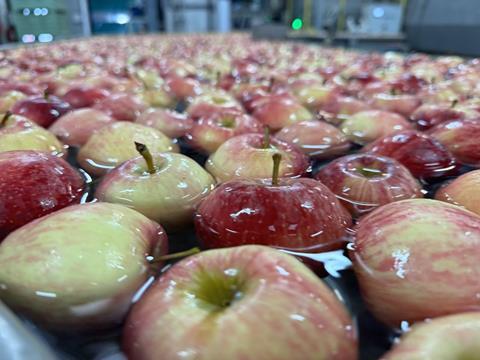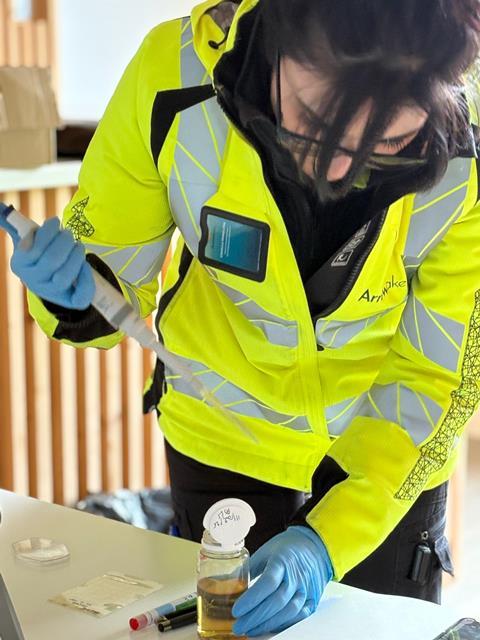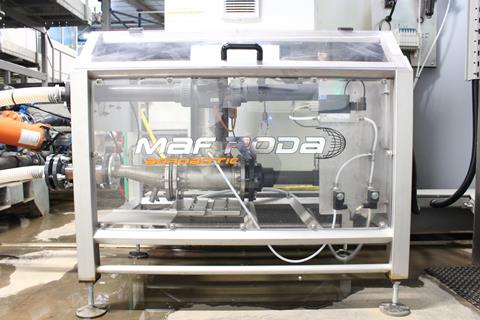In the face of growing concerns over water scarcity, Camilla Khrulova, CEO of Sweden’s JC Environment, sees ozone as the environmentally responsible solution to water treatment in the fresh produce sector

At a time when water scarcity and environmental sustainability are becoming increasingly pressing concerns, innovative solutions to manage and treat water in the food industry are evidently more critical than ever.
France’s MAF Roda has partnered with Arrow Lake and JC Environment in Sweden to jointly address the water treatment challenges faced by their customers. JC Environment is at the forefront of one such innovation: ozone treatment, and CEO Camilla Khrulova spoke to Fruitnet about its advantages and how the food industry can benefit from this natural solution.
Camilla, could you explain how ozone treatment works and what advantages it offers for the fresh produce sector?
Camilla Khrulova: Water treatment isn’t exactly a new concept. As long as food production has existed, water has been a key element. However, up until recent years, water treatment has often been viewed as a burden, something for the producers to manage as part of the process. Traditionally, water was seen as an unlimited resource, and there wasn’t much focus on sustainability.
In some regions, producers would pump water from the ground or use water from the grid, adding chemicals like chlorine to disinfect it, before discharging it back into nature, sometimes with little thought about the environmental impact. But in recent years, the situation has changed dramatically. In places like South Africa, where they’ve reached ‘Day Zero’ with no water left, or the south of Spain, the question of water availability and quality has become critical.
This is where ozonation comes in really handy. Ozone, which is created naturally through lightning and storms, is a powerful oxidant that can be used to disinfect water without leaving harmful chemicals behind. It is made by passing electricity through oxygen, and it’s this natural process that makes it such a sustainable and effective solution for water treatment. The real benefit is that once the ozone treatment process stops, you’re left with nothing but oxygen—there are no harmful chemical residues left in the water. This makes it a safe, sustainable solution for water reuse, particularly in food production where quality and hygiene are paramount.
In terms of its effectiveness, how does ozone compare to chlorine-based treatments that have been used in the past?
CK: I always say it’s not fair to compare ozone directly to chlorine because they’re fundamentally different. Chlorine is great at disinfecting water, and it’s cheap and easy to use, which is why it’s been so popular. But one of its drawbacks is that it remains in the water, and over time, you get byproducts like chlorates, which are carcinogenic. Plus, you have to keep adding chlorine to the water, and at some point, that becomes unsustainable.

While this solution was effective in the past, evolving regulations and stricter compliance requirements now demand an alternative approach — one that aligns with the latest standards and supports producers in meeting these heightened expectations
Ozone is much more versatile. It tackles a much broader range of contaminants, not just bacteria. It also treats biofilm, which is a real issue in water systems. Another key advantage is that it allows you to preserve energy. For instance, when you’re cooling or heating water, that energy is typically wasted when you discharge chlorinated water. But with ozone, you can reuse the water and maintain that energy efficiency.
Has ozone treatment been used in the food industry before, or is it a relatively new approach?
CK: Ozone itself is not new at all. It was discovered in the 19th century and has been used for decades to treat drinking water and wastewater around the world. But when it comes to food production, there have been challenges in the past. The main problem was, since ozone is a gas, when you try to introduce it into water, it tends to escape very quickly, much like when you open a bottle of soda, presenting a big safety challenge for operators. Thanks to advances in technology, we’ve solved that problem. We’ve developed systems that allow the ozone to stay in the water and work as intended. We’ve also automated the process, so it adjusts the dosage of ozone based on the quality of the water throughout the day.
Are your customers already aware of the benefits of ozone treatment, or do you need to educate them about the potential issues with chlorination?
CK: It depends on where the customers are located. In regions like South Africa, where water scarcity is a real problem, or southern Europe, where water quality is a major concern, customers are very aware of the need for water reuse.
In other areas, like southern France, where water is still relatively abundant and free, there’s less urgency to adopt sustainable water treatment practices. It’s frustrating, because even though the water may be ‘free’, the inefficiencies of the system — such as the energy wasted in heating and cooling water — still make ozone a more economical and sustainable solution for the future.
Overall, the trend is changing. Just five or six years ago, nobody wanted to talk about water treatment at events like Fruit Logistica. But now, more and more people are realising the importance of sustainability, and that’s driving demand for alternatives to traditional chlorination.
You’re working with sorting and grading manufacturer MAF Roda at the moment. Is ozone water treatment a big part of their plans?
CK: MAF Roda is way ahead of the competition on this. Rather than offering generic or theoretical solutions, MAF Roda committed to developing future-proofed approaches — combining advanced mechanical filtration with ozone treatment — to ensure sustainable and effective results.

Of course, for MAF it’s a win-win, because their equipment lasts longer, and it also gives a competitive edge because the customer doesn’t have to worry about water treatment. Ozone treatment is being rolled out on all new MAF Roda installations, and for all the previous ones that have been installed, every time there is maintenance that needs to be done, it is also being offered.
What sets MAF Roda apart even further is the establishment of the MAF Water Excellence Centre, where a dedicated team of experts carefully studies each customer’s water, analysing both chemical and microbiological parameters. This allows for the development of customised, proven treatment solutions tailored precisely to the specific water quality and the product being processed.
The initiative is led by myself as head of the MAF Water Excellence Centre and Gregory Varennes, technical director at MAF Roda. Together we are driving innovation with a clear focus on quality, precision and long-term value for the customer.
How do you see the future of water treatment in the food industry?
CK: I think the future is all about adaptability and sustainability. As water becomes a more scarce and precious resource, the industry will need to adopt more advanced and efficient treatment systems like ozonation. We need to be realistic. Change takes time, and not everyone will adopt these solutions immediately. The challenge is in communicating the long-term benefits, both in terms of cost savings and environmental impact. The ability to reuse water safely and effectively will be critical in the future, and ozone is one of the few solutions that can deliver on that front.



